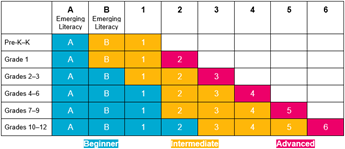- New to English
- May have interrupted access to education
- May have early literacy in their home language
- May go through a silent period or cultural adjustment
- Limited awareness of school organization or culture
|
- Little or no exposure to English instruction
- May have interrupted access to education
- May have emerging literacy in their home language
|
- May have some prior English instruction
- May have received support for English literacy development due to gaps in schooling
- May be literate in their home language(s)
|
- Some previous schooling and prior English instruction
- May have been in Canada for some time with academic language gaps
- Conversational English close to fluency
- Age‐appropriate literacy in home language(s)
- Grade 1 advanced English level
|
- May have studied English in home country
- Reading aloud fluently
- Reading comprehension approaching grade-level with scaffolding, vocabulary instruction, and extra time
- Grade-level in conversational English
- Grades 2–3 advanced English level
|
- May have studied in English for several years (International or Canadian schools)
- Academic oral proficiency is approaching fluency
- Writing approaching grade-level with scaffolding, vocabulary instruction, and extra time
- Grades 4–6 advanced English level
|
- Fluency in social and academic listening and speaking
- Reading and writing at grade-level in a variety of familiar contexts with scaffolding, direct instruction, and extra time
- Grades 7–9 advanced English level
|
- Grades 10–12 advanced English level
- Reading and writing at grade-level in a variety of new academic contexts with explicit instruction to understand low-frequency academic vocabulary in all subject areas, literature and cultural references, word choices, and advanced grammatical structures
|

